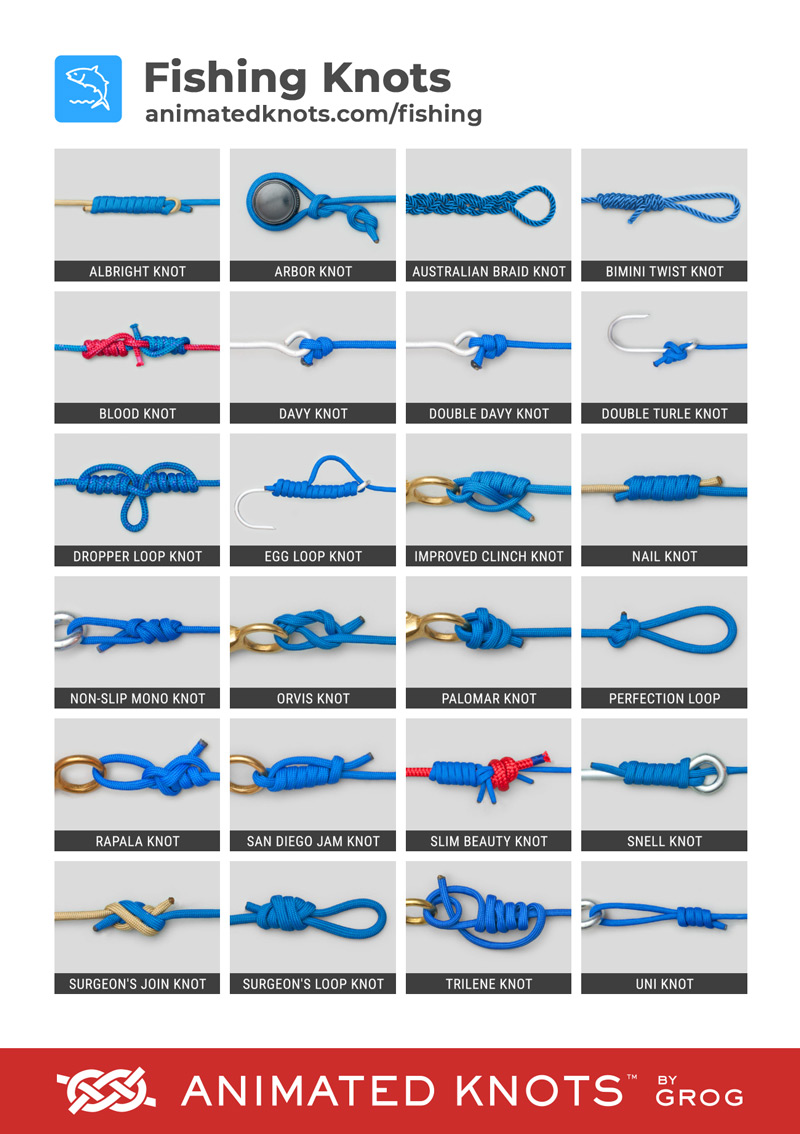Best Saltwater Fishing Knots to Learn: Master Every Catch
Saltwater fishing requires strong and reliable knots. These knots ensure your catch stays secure.
Fishing is more than just casting a line. It involves skill and knowledge, especially when dealing with the powerful creatures of the sea. Using the right fishing knots can make all the difference. Strong knots withstand the force of large fish and the harsh saltwater environment.
Whether you are a beginner or a seasoned angler, learning the best saltwater fishing knots can improve your fishing experience. Good knots can mean the difference between landing the big one and telling a story about the one that got away. Ready to dive in and discover the essential knots every saltwater angler should know? Let’s get started!

Credit: www.animatedknots.com
Introduction To Saltwater Fishing Knots
Saltwater fishing is an exciting and rewarding hobby. But to succeed, you need strong and reliable knots. The right knots ensure your catch stays secure. Learning the best saltwater fishing knots is crucial for every angler.
Importance Of Strong Knots
Strong knots are essential in saltwater fishing. They help withstand the powerful pull of ocean fish. These knots ensure your line stays intact under stress. Weak knots can lead to lost fish and broken lines.
A strong knot means a secure catch. It provides confidence in your fishing gear. Using the best knots increases your chances of success. It also helps protect your equipment from damage.
Common Challenges
Learning saltwater fishing knots can be challenging. Tying knots in wet and slippery conditions is tough. Saltwater can weaken knots over time. Ensuring knots are tight and secure is vital.
Many anglers struggle with complex knot techniques. Practice and patience are key. Understanding the common challenges helps in overcoming them. Using the right tools can also make knot tying easier.
| Knot Type | Strength | Use |
|---|---|---|
| Palomar Knot | High | Hooks, Lures |
| Improved Clinch Knot | Moderate | General Use |
| Double Uni Knot | Strong | Joining Lines |
Understanding the importance of strong knots and the common challenges helps in choosing the right knot. This knowledge enhances your saltwater fishing experience. Make sure to practice regularly to perfect these knots.

Credit: kastking.com
Essential Tools For Knot Tying
When preparing for saltwater fishing, having the right tools for knot tying is crucial. Using the correct equipment ensures your knots are strong and reliable. This section will guide you through the essential tools for knot tying.
Necessary Equipment
First, you need a good pair of fishing pliers. These help you tighten knots and trim excess line. Choose pliers made of stainless steel to prevent rust.
Next, have a reliable knot-tying tool. This tool simplifies the process of creating complex knots. It is especially useful for beginners.
Another essential item is a line cutter or scissors. Sharp cutters ensure clean cuts, which are vital for secure knots. Always keep them sharp for best results.
Lastly, a spool of high-quality fishing line is important. Different lines suit different fish and conditions. Choose a line that matches your specific fishing needs.
Tool Maintenance
Maintaining your tools is important for their longevity. Regularly clean and dry your fishing pliers. This prevents rust and keeps them in good condition.
Check your knot-tying tool for any signs of wear. Replace it if it becomes damaged to avoid weak knots.
Keep your line cutter sharp. Dull blades make it hard to cut the line cleanly. Regularly sharpen or replace the blade as needed.
Store your tools in a dry place. Moisture can cause rust and damage. A dedicated tackle box with compartments works well.
Knot Terminology
Understanding fishing knot terminology can make learning knots easier. Knowing the basic and advanced terms will help you tie knots correctly. Let’s explore these terms in detail.
Basic Terms
Here are some basic terms you’ll come across:
- Standing End: The longer part of the line not being used to tie the knot.
- Tag End: The short end of the line, used to tie the knot.
- Loop: A curve in the line that doesn’t cross itself.
- Bight: A section of line that bends back on itself, forming a U-shape.
Advanced Terms
Advanced terms add more precision to knot-tying:
- Turn: A single wrap of the line around an object or itself.
- Half Hitch: A simple knot made by looping the tag end around the standing end.
- Overhand Knot: A basic knot created by forming a loop and passing the tag end through it.
- Splice: Joining two lines by interweaving their strands.

Credit: www.flyfisherman.com
Improved Clinch Knot
The Improved Clinch Knot is one of the most reliable fishing knots. It’s simple to tie and works well in both freshwater and saltwater. Many anglers prefer it due to its strength and ease of use. This knot is perfect for securing a fishing line to a hook, lure, or swivel. Learning this knot can greatly improve your fishing experience.
Step-by-step Instructions
Follow these steps to tie the Improved Clinch Knot:
- Thread the end of the line through the eye of the hook.
- Wrap the tag end around the standing line five to seven times.
- Pass the tag end through the small loop near the hook’s eye.
- Pass it through the large loop you just created.
- Moisten the knot and pull on the tag end to tighten.
- Trim the excess line close to the knot.
Best Uses
The Improved Clinch Knot is versatile. It works well with most fishing lines. Use it for tying hooks, lures, and swivels. This knot is especially good for small to medium-sized fish. Anglers often use it in both freshwater and saltwater fishing. It is reliable and easy to tie, making it a favorite among beginners and experts.
Palomar Knot
The Palomar Knot is a versatile and reliable knot for saltwater fishing. It is known for its strength and simplicity. Many anglers prefer this knot for tying hooks, lures, and swivels to their lines. The Palomar Knot provides a strong, reliable connection, making it a top choice for both beginners and experienced fishermen.
Tying Process
- Double about 6 inches of line and pass it through the eye of the hook.
- Tie a simple overhand knot with the doubled line.
- Pass the loop over the hook.
- Moisten the knot and pull both ends to tighten it.
- Trim the excess line.
Strengths And Weaknesses
| Strengths | Weaknesses |
|---|---|
|
|
Double Uni Knot
The Double Uni Knot is a versatile and reliable fishing knot. Anglers use it to join two lines of similar or different materials. It is especially popular in saltwater fishing due to its strength and ease of tying.
Detailed Guide
To tie the Double Uni Knot, follow these steps:
- Overlap the ends of the two lines you wish to join.
- With one end, form a loop and then pass the tag end around both lines six times.
- Pull the tag end to tighten the knot.
- Repeat the process with the other line.
- Pull both standing lines to slide the two knots together.
- Trim any excess line from the tag ends.
Practice these steps until you can tie the knot quickly and confidently.
Applications In Fishing
The Double Uni Knot is useful for various fishing scenarios. It is ideal for connecting monofilament to fluorocarbon leaders. It is also effective for joining braided lines to monofilament or fluorocarbon. This knot provides a strong and secure connection. It maintains its integrity even under heavy loads. Many saltwater anglers rely on it for its reliability. Whether you are targeting big game fish or smaller species, the Double Uni Knot is an essential skill.
Loop Knots
Loop knots are essential for saltwater fishing. They allow more natural lure movement. This makes them ideal for catching fish in open water. Learning these knots can improve your fishing experience. Let’s dive into the types and uses of loop knots.
Types Of Loop Knots
There are several types of loop knots. Each has its own benefits.
- Surgeon’s Loop Knot: This knot is quick and easy to tie. It is strong and reliable.
- Non-Slip Loop Knot: Also known as the Kreh Loop Knot. It is great for lures that need more action.
- Perfect Loop Knot: This knot forms a clean loop. It is useful for attaching leaders.
- Double Overhand Loop Knot: This knot is very secure. It is often used for heavy lines.
When To Use Them
Choosing the right loop knot depends on the situation.
| Knot Type | Best Use |
|---|---|
| Surgeon’s Loop Knot | Quick attachment of hooks and lures |
| Non-Slip Loop Knot | When lures need more action |
| Perfect Loop Knot | Attaching leaders cleanly |
| Double Overhand Loop Knot | Securing heavy lines |
Using the right knot can make a big difference. It can help you catch more fish. Practice these knots to improve your fishing skills.
Tips For Perfect Knots
Learning the best saltwater fishing knots can make a big difference. A well-tied knot ensures your catch does not slip away. Here are some tips to help you tie perfect knots every time.
Practice Techniques
Practice makes perfect. Start by using a rope or a large piece of string. This helps you see the details of the knot. Once you feel comfortable, switch to your fishing line. Repetition builds muscle memory. So, practice tying the same knot many times.
Watch video tutorials or use diagrams. Visual aids help you understand the process better. Try tying knots in different conditions. Practice in low light or with wet hands. This prepares you for real fishing conditions.
Common Mistakes To Avoid
Avoid using the wrong type of line for your knot. Some knots work better with specific lines. For example, the Palomar knot works well with braided lines. Another common mistake is not wetting the line before tightening the knot. Wetting reduces friction and prevents the line from weakening.
Make sure the knot is tight. A loose knot can slip and fail. Check your knots regularly. Fishing lines can wear out over time. Retie your knots if you notice any wear or damage. Lastly, avoid rushing. Take your time to tie each knot correctly.
| Common Mistake | Solution |
|---|---|
| Using wrong type of line | Match knot to line type |
| Not wetting the line | Always wet the line |
| Knot is too loose | Tighten the knot properly |
| Rushing the process | Take your time |
Frequently Asked Questions
What Are The Essential Saltwater Fishing Knots?
The essential saltwater fishing knots include the Palomar Knot, Improved Clinch Knot, and the Loop Knot. These knots ensure strong, reliable connections for various fishing situations. Mastering these knots is crucial for successful saltwater fishing.
How Do You Tie A Palomar Knot?
To tie a Palomar Knot, double your line, pass it through the hook eye, and make an overhand knot. Then, pass the hook through the loop and tighten. It’s a strong and simple knot.
Why Is The Improved Clinch Knot Important?
The Improved Clinch Knot provides a secure connection for attaching hooks, lures, and swivels. It’s easy to tie and highly reliable. This knot is crucial for preventing line slippage during fishing.
What Is The Loop Knot Used For?
The Loop Knot is used to give lures and baits more natural movement. It creates a loop at the end of the line. This knot is perfect for presenting bait in a lifelike manner.
Conclusion
Learning the best saltwater fishing knots boosts your success on the water. Practice these knots regularly for better results. They ensure your gear stays secure and reliable. Strong knots make a big difference in catching fish. Keep these techniques in mind on your next fishing trip.
Enjoy a rewarding and more fruitful experience. Happy fishing!


